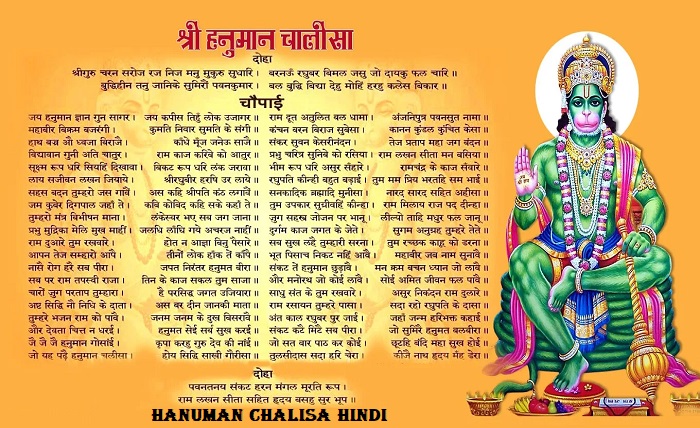The Hanuman Chalisa in Hindi: A Divine Hymn of Strength, Devotion, and Power
In the vast and profound ocean of Hindu devotional literature, few texts shine as brightly and are as universally cherished as the Hanuman Chalisa in Hindi. Composed by the 16th-century poet-saint Goswami Tulsidas, this 40-verse hymn is a magnificent ode to Lord Hanuman, the epitome of devotion, strength, courage, and selfless service. The enduring popularity of the Hanuman Chalisa in Hindi transcends regional and linguistic barriers, making it a spiritual cornerstone in millions of households. Its verses, written in Awadhi, a dialect of Hindi, are not merely words to be recited; they are considered a potent mantra, a source of immense positive energy, and a direct conduit to the divine grace of Bajrangbali. For centuries, devotees have turned to the Hanuman Chalisa in Hindi for solace, protection, and the strength to overcome life’s most formidable challenges, testifying to its timeless relevance and miraculous power.
The Historical Origin and Divine Composition of the Hanuman Chalisa in Hindi
The genesis of the Hanuman Chalisa in Hindi is as miraculous as the deity it praises. It was penned by Goswami Tulsidas, a devotee of Lord Rama, in the city of Varanasi. According to popular legend, Tulsidas was a contemporary of the Mughal emperor Akbar. The story goes that Tulsidas was summoned by Akbar to perform a miracle. When Tulsidas declined, stating he had no miraculous powers, he was imprisoned. It was in this captivity that he is believed to have composed the Hanuman Chalisa in Hindi, chanting 40 verses with unwavering faith. On the 40th recitation, it is said that an army of monkeys descended upon Akbar’s court, wreaking havoc until the emperor released Tulsidas with apologies and offerings. This legend, whether historical or metaphorical, powerfully establishes the protective and liberating energy inherent in the Hanuman Chalisa in Hindi. Tulsidas wrote it not in Sanskrit, the language of scholars, but in Awadhi, making the profound wisdom of the Ramayana and the glories of Hanuman accessible to the common person. This deliberate choice cemented the Hanuman Chalisa in Hindi as a scripture of the people, for the people.
The Structure and Meaning of the Hanuman Chalisa in Hindi
The term “Chalisa” is derived from the Hindi word “chalis,” which means forty. True to its name, the Hanuman Chalisa in Hindi consists of forty verses, plus a couplet of invocation at the beginning and a prayer at the end. The structure is poetic and metrical, written in the popular “Chaupai” meter, which gives it a rhythmic and melodic quality when sung or recited. The Hanuman Chalisa in Hindi begins with two introductory couplets (Dohas), where Tulsidas invokes the grace of his gurus and sets the intention for the composition. The core forty verses can be thematically divided into several sections: the first few verses praise Hanuman’s divine birth and his noble qualities; the subsequent verses eloquently describe his heroic deeds from the Ramayana, such as leaping across the ocean to Lanka, burning it with his fiery tail, and bringing the sanjeevani herb to save Lakshmana’s life. The Hanuman Chalisa in Hindi then elaborates on the various boons he received from different gods and his role as a devoted servant of Lord Rama. The final verses are a heartfelt prayer, listing the benefits that accrue to one who remembers and chants the Hanuman Chalisa in Hindi with sincerity.
The Immense Spiritual and Psychological Benefits of Reciting the Hanuman Chalisa in Hindi
The recitation of the Hanuman Chalisa in Hindi is believed to confer a multitude of benefits, both spiritual and worldly. On a spiritual level, it is said to purify the mind and body, remove negative energies and spirits (bhoot-pishach), and create a protective shield of divine light around the devotee. Chanting the Hanuman Chalisa in Hindi with devotion is a powerful sadhana (spiritual practice) that helps cultivate virtues like courage (shaurya), humility (vinamrata), and unwavering devotion (bhakti). Psychologically, the rhythmic chanting acts as a form of meditation, calming the nervous system, reducing stress and anxiety, and instilling a profound sense of peace and confidence. The verses of the Hanuman Chalisa in Hindi are a reminder of Hanuman’s immense strength and his ability to overcome any obstacle, which in turn empowers the devotee to face their own life challenges with renewed vigor and optimism. It is often recited for protection during travel, for success in difficult endeavors, and for healing from illness and fear. The holistic benefits of the Hanuman Chalisa in Hindi make it a complete tool for overall well-being.
A Guide to the Correct Way of Reciting the Hanuman Chalisa in Hindi
While the sincere devotion of the heart is the most important element, following certain traditional practices can enhance the efficacy of reciting the Hanuman Chalisa in Hindi. It is most auspicious to chant it in the morning during Brahma Muhurta (the pre-dawn hours) or in the evening. Before beginning, one should sit facing East or North, on a clean mat or cloth. It is beneficial to light a diya (lamp) with mustard oil or ghee and offer a simple prayer to Lord Hanuman, perhaps with a red flower, sindoor, or a roundel of besan laddu. The Hanuman Chalisa in Hindi should be chanted clearly, with correct pronunciation and a focused mind. While reciting from memory is ideal, reading from a clean physical copy or a digital device is also acceptable. Many devotees make it a daily practice to chant it 1, 3, 7, or 108 times, especially on Tuesdays and Saturdays, which are considered particularly auspicious for Hanuman. The key is consistency (nitya) and emotional connection (bhavana). Completing the recitation with a prayer for everyone’s well-being amplifies the positive effects of the Hanuman Chalisa in Hindi.
The Hanuman Chalisa in Hindi in Modern Times: Digital Accessibility and Global Reach
In today’s digital age, the Hanuman Chalisa in Hindi has found a new and powerful medium for propagation. Its reach is no longer confined to physical books or temples. A simple search online yields countless websites, apps, and YouTube videos featuring the complete text, its meaning, and audio renditions by renowned singers and priests. This digital accessibility has allowed the Hanuman Chalisa in Hindi to travel across the globe, providing solace and connection to the diaspora and spiritual seekers everywhere. Whether someone is on a morning commute, at work, or in a foreign land, they can easily access and listen to the Hanuman Chalisa in Hindi. Social media platforms are filled with groups and pages where devotees share their experiences and insights related to the Hanuman Chalisa in Hindi. This technological embrace has ensured that this ancient hymn remains vibrantly relevant, continuing to inspire and protect a new, global generation of devotees.
Exploring the Deeper Symbolism Within the Hanuman Chalisa in Hindi
The Hanuman Chalisa in Hindi is not just a narrative of events; it is a rich tapestry of spiritual symbolism. Hanuman himself symbolizes the perfect mind—a mind devoted to the higher self (Rama), endowed with immense power, yet humble and selfless. His leap to Lanka represents the mind’s journey to overcome the ocean of illusions (Maya) to find the liberating truth (Sita). The burning of Lanka signifies the burning of negative desires and ego. The sanjeevani herb he brings is the healing power of divine knowledge that revives our dormant consciousness (Lakshmana). When the Hanuman Chalisa in Hindi describes Hanuman as residing in the heart alongside Rama, Sita, and Lakshmana, it signifies the ultimate state of yoga—union with the divine. Every verse of the Hanuman Chalisa in Hindi holds these deeper layers of meaning, offering profound philosophical insights to those who contemplate them. It is a guidebook for spiritual awakening, using the epic story of the Ramayana as its metaphor.
Personal Experiences and Transformative Stories of the Hanuman Chalisa in Hindi
The true power of the Hanuman Chalisa in Hindi is perhaps best illustrated by the countless personal anecdotes and transformative experiences shared by devotees over centuries. Many narrate stories of miraculous recoveries from critical illnesses, protection from grave accidents, and sudden solutions to seemingly insurmountable problems after taking up the regular chanting of the Hanuman Chalisa in Hindi. Students chant it for focus and success in exams, professionals for confidence in their careers, and individuals for strength during times of grief and despair. These stories are not merely superstition; they point to the psychological and spiritual impact of consistently filling one’s mind with powerful, positive, and courageous vibrations. The unwavering faith (shraddha) with which the Hanuman Chalisa in Hindi is recited acts as a key, unlocking inner reservoirs of strength and inviting divine intervention, making the impossible possible. These lived experiences continue to fuel the unwavering faith in the Hanuman Chalisa in Hindi.
Conclusion
The Hanuman Chalisa in Hindi is far more than a religious poem; it is a timeless spiritual classic, a powerhouse of positive energy, and a compassionate guide for humanity. Its verses, soaked in devotion, valor, and wisdom, offer a practical path to overcoming fear, cultivating strength, and attaining peace. From the historical courts of Akbar to the digital screens of the 21st century, its resonant power remains undimmed. Whether one seeks protection, peace, courage, or a deeper connection with the divine, the Hanuman Chalisa in Hindi stands as a readily accessible, profoundly effective, and eternally benevolent force. Embracing the daily practice of reciting the Hanuman Chalisa in Hindi can truly be a transformative journey, leading the devotee from weakness to strength, and from darkness to light.
FAQs
1. Why is the Hanuman Chalisa called ‘Chalisa’?
The Hanuman Chalisa in Hindi is called ‘Chalisa’ because it contains forty verses. The Hindi word “chalis” means forty, and the hymn is structured around these forty core chaupais (quatrains).
2. Can women recite the Hanuman Chalisa in Hindi?
Absolutely. There are no restrictions based on gender. The Hanuman Chalisa in Hindi is a universal hymn of strength and devotion that can be recited by anyone, regardless of gender, age, or background, with sincere faith.
3. What is the best time to recite the Hanuman Chalisa in Hindi?
The most auspicious times are at sunrise (Brahma Muhurta) and sunset. Tuesdays and Saturdays are considered especially significant for Hanuman. However, it can be chanted at any time with pure intent.
4. Do I need to know Hindi to recite the Hanuman Chalisa?
While knowing Hindi helps with understanding the meaning, the phonetic recitation of the Hanuman Chalisa in Hindi is considered powerful due to the vibrational quality of the sounds. Many non-Hindi speakers learn to chant it phonetically and still experience its benefits.
5. How many times should I chant the Hanuman Chalisa in Hindi for a specific problem?
For general well-being, a daily recitation is recommended. For specific challenges, devotees often undertake to chant the Hanuman Chalisa in Hindi 108 times (a “mandala”) or for 40 consecutive days (an “anushthan”) with a focused prayer.


